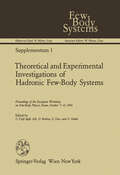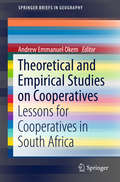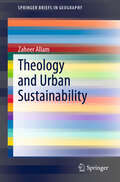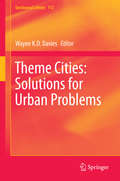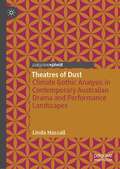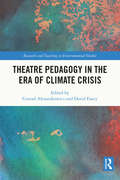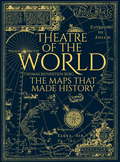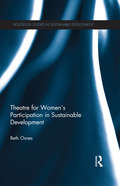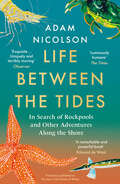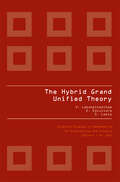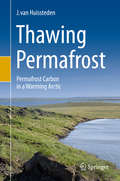- Table View
- List View
Theoretical and Observational Cosmology (Nato Science Series C: #541)
by Marc Lachièze-ReyA complete account of the fundamental techniques of general relativity and their application to cosmology. The book includes reviews of the different cosmological models and their classification, including such topics as causality and horizons, the cosmological parameters, observational tests and constraints of cosmology, symmetries and the large scale topology of space and space-time, and the use of supernovas as cosmological indicators. The perturbations to the cosmological models are discussed throughout the volume. The cosmic microwave background is presented, with an emphasis in secondary distortions in relation to cosmological models and large scale structures. Recent results on dark matter are summarised. A general review of primordial nucleosynthesis is given. Gravitational lensing is discussed in great detail. Most contributions show a balance between theory and observation. Readership: A solid background for students and researchers intending to work in the field of theoretical and observational cosmology.
Theoretical and Numerical Unsaturated Soil Mechanics (Springer Proceedings in Physics #113)
by Tom SchanzThese proceedings are a continuation of the series of International Conferences in Germany entitled "Mechanics of Unsaturated Soils." The primary objective is to discuss and understand unsaturated soil behaviour such that engineered activities are made better with times in terms of judgment and quality. The proceedings contain recent research by leading experts in Mechanics of Unsaturated Soils.
Theoretical and Experimental Investigations of Hadronic Few-Body Systems: Proceedings of the European Workshop on Few-Body Physics, Rome, October 7–11, 1986 (Few-Body Systems #1)
by Claudio Ciofi Degli Atti Omar Benhar Emanuele Pace Giovanni SalmeThis volume collects the papers given at the European Workshop "Theoretical and Experimental Investigations of Hadronic Few-Body Systems" which, adhering to an invitation of the European Few-Body Physics Research Committee, was organized in Rome on October 7-11, 1986. All papers presented at the workshop appear in the volume, plus two papers which could not be presented orally because their authors were at the last moment unable to attend. The list of contents closely follows the programme of the workshop. The workshop, attended by 128 American, European, and Japanese physicists from 60 different institutions and universities, was sponsored by the Italian National Institute for Nuclear Physics (lNFN) and was organized by the INFN Section located at the Istituto Superiore di Sanita (ISS), which kindly provided the venue for the meeting and many related facilities. The goal of the workshop was to summarize the present situa tion and the future perspectives concerning the theoretical descriptions of strongly interacting few-body systems and their experimental investigation by electromagnetic and hadronic probes, mainly at intermediate energies. To this end, representatives from most international groups working within different theoretical methods and with different experimental facilities, were invited and asked to illustrate their latest results and future research programs; the intention was to provide, by this way, an impartial and broad information which could be useful to whom is actively working in few body physics, as well as to young students entering this field of research.
Theoretical and Empirical Studies on Cooperatives: Lessons for Cooperatives in South Africa (SpringerBriefs in Geography)
by Andrew Emmanuel Emmanuel OkemThe book outlines how cooperatives can be used as a tool for development and reconciliation in post-conflict contexts. This book also examines the successes and challenges for emerging and existing cooperatives in Africa, while delivering both practical lessons and insights into the theory. It presents completely new materials on the cooperative movement, against a backdrop of increasing global recognition of the roles of cooperatives and collective action in socio-economic development. Readers are invited to consider how, as an economic model that seeks to advance member collective interests, cooperatives are invaluable tools for human, economic and social development. Social and human geographers find this a remarkably impactful contribution to the literature surrounding cooperatives in Africa and cooperative theory in general. Policy experts and students also find the research informative and insightful.
Theoretical and Applied Aerodynamics: and Related Numerical Methods
by J. J. Chattot M. M. HafezThis book covers classical and modern aerodynamics, theories and related numerical methods, for senior and first-year graduate engineering students, including:-The classical potential (incompressible) flow theories for low speed aerodynamics of thin airfoils and high and low aspect ratio wings.- The linearized theories for compressible subsonic and supersonic aerodynamics.- The nonlinear transonic small disturbance potential flow theory, including supercritical wing sections, the extended transonic area rule with lift effect, transonic lifting line and swept or oblique wings to minimize wave drag. Unsteady flow is also briefly discussed. Numerical simulations based on relaxation mixed-finite difference methods are presented and explained.- Boundary layer theory for all Mach number regimes and viscous/inviscid interaction procedures used in practical aerodynamics calculations.There are also four chapters covering special topics, including wind turbines and propellers, airplane design, flow analogies and hypersonic (rotational) flows.A unique feature of the book is its ten self-tests and their solutions as well as an appendix on special techniques of functions of complex variables, method of characteristics and conservation laws and shock waves. The book is the culmination of two courses taught every year by the two authors for the last two decades to seniors and first-year graduate students of aerospace engineering at UC Davis.
Theoretical Advances in Neural Computation and Learning
by Vwani Roychowdhury Kai-Yeung Kai-Yeung Siu Alon OrlitskyFor any research field to have a lasting impact, there must be a firm theoretical foundation. Neural networks research is no exception. Some of the founda tional concepts, established several decades ago, led to the early promise of developing machines exhibiting intelligence. The motivation for studying such machines comes from the fact that the brain is far more efficient in visual processing and speech recognition than existing computers. Undoubtedly, neu robiological systems employ very different computational principles. The study of artificial neural networks aims at understanding these computational prin ciples and applying them in the solutions of engineering problems. Due to the recent advances in both device technology and computational science, we are currently witnessing an explosive growth in the studies of neural networks and their applications. It may take many years before we have a complete understanding about the mechanisms of neural systems. Before this ultimate goal can be achieved, an swers are needed to important fundamental questions such as (a) what can neu ral networks do that traditional computing techniques cannot, (b) how does the complexity of the network for an application relate to the complexity of that problem, and (c) how much training data are required for the resulting network to learn properly? Everyone working in the field has attempted to answer these questions, but general solutions remain elusive. However, encouraging progress in studying specific neural models has been made by researchers from various disciplines.
Theology and Urban Sustainability (SpringerBriefs in Geography)
by Zaheer AllamEven though theology does provide interesting and important contributions to ethics that laid the foundation of our modern societies, this book looks at exploring how theology has impacted on urban morphology and has led to questionable unsustainable practices which impacts on both climate and societal living standards. This is seen as being accelerated with the impacts of climate change coupled with increasing urbanisation rates that stresses on contemporary notions and foundations, as initially sparked by religion. Through an argumentative style, the author sets forth to explore the ethics of religious dogmas in a rapidly urbanising world that is stressed by increasing consumption from a booming demographic.
The THEMIS Mission
by James L. Burch Vassilis AngelopoulosJ.L. Burch·V. Angelopoulos Originally published in the journal Space Science Reviews, Volume 141, Nos 1–4, 1–3. DOI: 10.1007/s11214-008-9474-5 © Springer Science+Business Media B.V. 2008 The Earth, like all the other planets, is continuously bombarded by the solar wind, which is variable on many time scales owing to its connection to the activity of the Sun. But the Earth is unique among planets because its atmosphere, magnetic eld, and rotation rates are each signi cant, though not dominant, players in the formation of its magnetosphere and its reaction to solar-wind inputs. An intriguing fact is that no matter what the time scale of solar-wind variations, the Earth’s response has a de nite pattern lasting a few hours. Known as a magnetospheric substorm, the response involves a build-up, a crash, and a recovery. The build-up (known as the growth phase) occurs because of an interlinking of the geom- netic eld and the solar-wind magnetic eld known as magnetic reconnection, which leads to storage of increasing amounts of magnetic energy and stress in the tail of the mag- tosphere and lasts about a half hour. The crash (known as the expansion phase) occurs when the increased magnetic energy and stresses are impulsively relieved, the current system that supports the stretched out magnetic tail is diverted into the ionosphere, and bright, dynamic displays of the aurora appear in the upper atmosphere. The expansion and subsequent rec- ery phases result from a second magnetic reconnection event that decouples the solar-wind and geomagnetic elds.
Theme Cities: Solutions for Urban Problems (GeoJournal Library #112)
by Wayne K.D. DaviesThis book reviews a series of new urban ideas or themes designed to help make cities more liveable, sustainable, safe and inclusive. Featuring examples drawn from cities all over the world, the various chapters provide critical assessments of each of the various approaches and their potential to improve urban life.New Urbanism: creating new areas based on a more humane scale with neighbourhood cohesionJust Cities: creating more fairness in decision-making so all residents can participate and benefit.Green Cities: helping places become greener with environmental rehabilitation and protection Sustainable Cities: avoiding the waste of resources and harmful pollution in settlementsTransition Towns: developing local initiatives for more sustainable actionsWinter Cities: making cities in cold climates more comfortable and enjoyable Resilient Cities: strengthening cities to better enable them to withstand natural hazardsCreative Cities: supporting cultural industries and attracting talented individuals Knowledge Cities: creating, renewing and spreading knowledge and innovation Safe Cities: ensuring that citizens are better protected against criminal actionsHealthy Cities: making improvements in the health of people in citiesFestive Cities: rediscovering the utility of festive events in settlementsSlow Cities: enhancing locally unique activities, such as local cuisines and community interactionsThis volume offers a host of approaches designed to give a new direction and focus to planning policies, helping readers to fully understand the advantages and disadvantages of each potential idea. It seeks to solve the many current problems associated with urban developments, making it a valuable resource for university and college students in urban geography, urban planning, urban sociology and urban studies as well as to planners and the general public.
Thematic Cartography, Thematic Cartography and Transformations (Iste Ser.)
by Colette Cauvin Francisco Escobar Aziz SerradjA thematic map is a map that illustrates more than simply geographical relationships or locations, but rather also portrays themes, patterns, or data relating to physical, social, medical, economic, political, or any other aspect of a region or location. Examples include maps that show variations of population density, climate data, wealth, voting intentions, or life expectancy with geographical location. These tools have become central to the work of scientists, practitioners, and students in nearly every field, from epidemiology to political science, and are familiar to members of the public as a common means of expressing complicated and multivariate information in easily understood graphical formats. This set of three volumes on Thematic Cartography considers maps as information constructs resulting from a number of successive information transformations and the products of decision stages, integrated into a logical reasoning and the order of those choices. It thereby provides a thorough understanding of the theoretical basis for thematic mapping, as well as the means of applying the various techniques and methodologies in order to create a desired analytical presentation. This first volume introduces the basics of thematic cartography. The authors present the transformations necessary to the production – using a scientific approach – of any thematic map. Four stages are detailed: from geographic entities to cartographic objects; the [XY] transformation; the [XYZ] cartographic transformations; and the semiotic transformation. Technical aspects giving map-reading keys are also included.
Thematic Cartography, Thematic Cartography and Transformations
by Colette Cauvin Francisco Escobar Aziz SerradjA thematic map is a map that illustrates more than simply geographical relationships or locations, but rather also portrays themes, patterns, or data relating to physical, social, medical, economic, political, or any other aspect of a region or location. Examples include maps that show variations of population density, climate data, wealth, voting intentions, or life expectancy with geographical location. These tools have become central to the work of scientists, practitioners, and students in nearly every field, from epidemiology to political science, and are familiar to members of the public as a common means of expressing complicated and multivariate information in easily understood graphical formats. This set of three volumes on Thematic Cartography considers maps as information constructs resulting from a number of successive information transformations and the products of decision stages, integrated into a logical reasoning and the order of those choices. It thereby provides a thorough understanding of the theoretical basis for thematic mapping, as well as the means of applying the various techniques and methodologies in order to create a desired analytical presentation. This first volume introduces the basics of thematic cartography. The authors present the transformations necessary to the production – using a scientific approach – of any thematic map. Four stages are detailed: from geographic entities to cartographic objects; the [XY] transformation; the [XYZ] cartographic transformations; and the semiotic transformation. Technical aspects giving map-reading keys are also included.
Thematic Cartography for the Society (Lecture Notes in Geoinformation and Cartography)
by Temenoujka Bandrova Milan Konecny Sisi Zlatanova“Thematic Cartography for the Society” is prepared on the basis of the best 30 papers presented at the 5th International Conference on Cartography and GIS held in Albena, Bulgaria in 2014.The aim of the conference is to register new knowledge and shape experiences about the latest achievements in cartography and GIS worldwide. At the same time, the focus is on the important European region - the Balkan Peninsula. The following topics are covered: User-friendly Internet and Web Cartography; User-oriented Map Design and Production; Context-oriented Cartographic Visualization; Map Interfaces for Volunteered Geographic Information; Sensing Technologies and their Integration with Maps; Cartography in Education. Focus on user-oriented cartographic approaches.
Thematic Cartography, Cartography and the Impact of the Quantitative Revolution: Cartography And The Impact Of The Quantitative Revolution
by Colette Cauvin Francisco Escobar Aziz SerradjThis series in three volumes considers maps as constructions resulting from a number of successive transformations and stages integrated in a logical reasoning and an order of choices. Volume 2 focuses on the impact of the quantitative revolution, partially related to the advent of the computer age, on thematic cartography.
Thematic Cartography, Cartography and the Impact of the Quantitative Revolution
by Colette Cauvin Francisco Escobar Aziz SerradjThis series in three volumes considers maps as constructions resulting from a number of successive transformations and stages integrated in a logical reasoning and an order of choices. Volume 2 focuses on the impact of the quantitative revolution, partially related to the advent of the computer age, on thematic cartography.
Thematic Cartography and Geovisualization, Fourth Edition
by Terry A. Slocum Robert B McMaster Fritz C. Kessler Hugh.H HowardThis comprehensive and well-established cartography textbook covers the theory and the practical applications of map design and the appropriate use of map elements. It explains the basic methods for visualizing and analyzing spatial data and introduces the latest cutting-edge data visualization techniques. The fourth edition responds to the extensive developments in cartography and GIS in the last decade, including the continued evolution of the Internet and Web 2.0; the need to analyze and visualize large data sets (commonly referred to as Big Data); the changes in computer hardware (e.g., the evolution of hardware for virtual environments and augmented reality); and novel applications of technology. Key Features of the Fourth Edition: Includes more than 400 color illustrations and it is available in both print and eBook formats. A new chapter on Geovisual Analytics and individual chapters have now been dedicated to Map Elements, Typography, Proportional Symbol Mapping, Dot Mapping, Cartograms, and Flow Mapping. Extensive revisions have been made to the chapters on Principles of Color, Dasymetric Mapping, Visualizing Terrain, Map Animation, Visualizing Uncertainty, and Virtual Environments/Augmented Reality. All chapters include Learning Objectives and Study Questions. Provides more than 250 web links to online content, over 730 references to scholarly materials, and additional 540 references available for Further Reading. There is ample material for either a one or two-semester course in thematic cartography and geovisualization. This textbook provides undergraduate and graduate students in geoscience, geography, and environmental sciences with the most valuable up-to-date learning resource available in the cartographic field. It is a great resource for professionals and experts using GIS and Cartography and for organizations and policy makers involved in mapping projects.
Thematic Cartography and Geovisualization, Fourth Edition
by Terry A. Slocum Robert B McMaster Fritz C. Kessler Hugh.H HowardThis comprehensive and well-established cartography textbook covers the theory and the practical applications of map design and the appropriate use of map elements. It explains the basic methods for visualizing and analyzing spatial data and introduces the latest cutting-edge data visualization techniques. The fourth edition responds to the extensive developments in cartography and GIS in the last decade, including the continued evolution of the Internet and Web 2.0; the need to analyze and visualize large data sets (commonly referred to as Big Data); the changes in computer hardware (e.g., the evolution of hardware for virtual environments and augmented reality); and novel applications of technology. Key Features of the Fourth Edition: Includes more than 400 color illustrations and it is available in both print and eBook formats. A new chapter on Geovisual Analytics and individual chapters have now been dedicated to Map Elements, Typography, Proportional Symbol Mapping, Dot Mapping, Cartograms, and Flow Mapping. Extensive revisions have been made to the chapters on Principles of Color, Dasymetric Mapping, Visualizing Terrain, Map Animation, Visualizing Uncertainty, and Virtual Environments/Augmented Reality. All chapters include Learning Objectives and Study Questions. Provides more than 250 web links to online content, over 730 references to scholarly materials, and additional 540 references available for Further Reading. There is ample material for either a one or two-semester course in thematic cartography and geovisualization. This textbook provides undergraduate and graduate students in geoscience, geography, and environmental sciences with the most valuable up-to-date learning resource available in the cartographic field. It is a great resource for professionals and experts using GIS and Cartography and for organizations and policy makers involved in mapping projects.
Theatres of Dust: Climate Gothic Analysis in Contemporary Australian Drama and Performance Landscapes
by Linda HassallThrough a contemporary Gothic lens, the book explores theatre theories, processes and practices that explore; the impacts of continuing drought and natural disaster, the conflicts concerning resource extraction and mining and current political debates focussed on climate change denial. While these issues can be argued from various political and economic platforms, theatrical investigations as discussed here suggest that scholars and theatre makers are becoming empowered to dramaturgically explore the ecological challenges we face now and may face in the future. In doing so the book proposes that theatre can engage in not only climate change analysis and discussion but can develop climate literacies in a broader socio-cultural context.
Theatre Pedagogy in the Era of Climate Crisis (Research and Teaching in Environmental Studies)
by Conrad Alexandrowicz David FancyThis volume explores whether theatre pedagogy can and should be transformed in response to the global climate crisis. Conrad Alexandrowicz and David Fancy present an innovative re-imagining of the ways in which the art of theatre, and the pedagogical apparatus that feeds and supports it, might contribute to global efforts in climate protest and action. Comprised of contributions from a broad range of scholars and practitioners, the volume explores whether an adherence to aesthetic values can be preserved when art is instrumentalized as protest and considers theatre as a tool to be employed by the School Strike for Climate movement. Considering perspectives from areas including performance, directing, production, design, theory and history, this book will prompt vital discussions which could transform curricular design and implementation in the light of the climate crisis. Theatre Pedagogy in the Era of Climate Crisis will be of great interest to students, scholars and practitioners of climate change and theatre and performance studies.
Theatre Pedagogy in the Era of Climate Crisis (Research and Teaching in Environmental Studies)
by Conrad Alexandrowicz David FancyThis volume explores whether theatre pedagogy can and should be transformed in response to the global climate crisis. Conrad Alexandrowicz and David Fancy present an innovative re-imagining of the ways in which the art of theatre, and the pedagogical apparatus that feeds and supports it, might contribute to global efforts in climate protest and action. Comprised of contributions from a broad range of scholars and practitioners, the volume explores whether an adherence to aesthetic values can be preserved when art is instrumentalized as protest and considers theatre as a tool to be employed by the School Strike for Climate movement. Considering perspectives from areas including performance, directing, production, design, theory and history, this book will prompt vital discussions which could transform curricular design and implementation in the light of the climate crisis. Theatre Pedagogy in the Era of Climate Crisis will be of great interest to students, scholars and practitioners of climate change and theatre and performance studies.
Theatre of the World: The History of Maps and the Men and Women Who Made Them
by Thomas Reinertsen Berg'Fascinating...sumptuously produced with lots of full-colour images, is a kind of potted treasury of cartographical history that gleams with pieces-of-eight-like snippets of information...this is an enthralling book, and joins the likes of Simon Garfield's On the Map and Jerry Brotton's A History of the World in Twelve Maps in the field of popular reaffirmations of the ingenuity of geography.' Travis Elborough, Spectator'A fascinating book that I will always treasure.' Sir Ranulph Fiennes 'This wonderful book is a reminder of how much careful thought was given to the shape of the world even in ancient times - the landscape, how places are related to one another. I pored over these maps for hours, imagining those minds hard at work, visualising how it all connected as a whole. Just brilliant.' Neil Oliver'Visually stunning...it's gone straight to the top of my Christmas present list.' The Bookseller'I remember how well I liked to turn the pages of my childhood atlas and travel the world to find out where countries and cities were. But there was never anything about why the maps were created - or who drew them. Theatre of the World was my big chance to tell the stories of all those men and women map makers whose amazing work deserves to be celebrated.' Thomas Reinertsen BergBeautifully illustrated and rich in detail, Theatre of the World reignites our curiosity with the world both ancient and modern. Before you could just put finger to phone to scroll Google Maps, in advance of the era of digital mapping and globes, maps were being constructed from the ideas and questions of pioneering individuals.From visionary geographers to heroic explorers, from the mysterious symbols of the Stone Age to the familiar navigation of Google Earth, Thomas Reinertsen Berg examines the fascinating concepts of science and worldview, of art and technology, power and ambitions, practical needs and distant dreams of the unknown.
Theatre for Women's Participation in Sustainable Development (Routledge Studies in Sustainable Development)
by Beth OsnesThough development researchers have proven that the participation of women is necessary for effective sustainable development, development practitioners still largely lack culturally appropriate, gender-sensitive tools for including women, especially women living in poverty. Current tools used in the development approach often favour the skill set of the development practitioner and are a mismatch with the traditional, gendered knowledge and skills many women who are living in poverty do have. This study explores three case studies from India, Ethiopia, and the Guatemala that have successfully used applied theatre for women’s participation in sustainable development. This interdisciplinary book has the opportunity to be the first to bring together the theory, scholarship and practice of theatre for women’s participation in sustainable development in an international context. This work will be of great interest to scholars and practitioners in a wide variety of fields who are looking for creative solutions for utilizing the contributions of women for solving our global goals to live in a sustainable way on this one planet in a just and equitable manner.
Theatre for Women's Participation in Sustainable Development (Routledge Studies in Sustainable Development)
by Beth OsnesThough development researchers have proven that the participation of women is necessary for effective sustainable development, development practitioners still largely lack culturally appropriate, gender-sensitive tools for including women, especially women living in poverty. Current tools used in the development approach often favour the skill set of the development practitioner and are a mismatch with the traditional, gendered knowledge and skills many women who are living in poverty do have. This study explores three case studies from India, Ethiopia, and the Guatemala that have successfully used applied theatre for women’s participation in sustainable development. This interdisciplinary book has the opportunity to be the first to bring together the theory, scholarship and practice of theatre for women’s participation in sustainable development in an international context. This work will be of great interest to scholars and practitioners in a wide variety of fields who are looking for creative solutions for utilizing the contributions of women for solving our global goals to live in a sustainable way on this one planet in a just and equitable manner.
the sea is not made of water: Life Between The Tides
by Adam Nicolson‘A remarkable and powerful book, the rarest of things … Nicolson is unique as a writer … I loved it’ EDMUND DE WAAL ‘Miraculous … An utterly fascinating glimpse of a watery world we only thought we knew’ PHILIP HOARE Few places are as familiar as the shore – and few as full of mystery and surprise.
THE HYBRID GRAND UNIFIED THEORY (Atlantis Studies in Mathematics for Engineering and Science #3)
by E. Escultura V. LakshmikanthamIn this book, an attempt is made to provide a hybrid grand unified theory to understand the universe, both in its micro/quantum aspects as well as macro/galactic aspects. The book describes a truly hybrid theory as it encompasses both the modern and ancient theories of the universe, together with its functioning at all levels of human comprehension. One of its authors, Dr Escultura, was nominated in 2005 for a Nobel Prize for his flux theory of gravitation. From then on this theory has been improved, clarified and is now known as the hybrid grand unified theory. This book deals with this new bold theory, unifying mathematics and physics, and answering some open fundamental questions and paradoxes in these disciplines. The book also describes what the ancient scientists knew about these matters.
Thawing Permafrost: Permafrost Carbon in a Warming Arctic
by J. van HuisstedenThis book provides a cross-disciplinary overview of permafrost and the carbon cycle by providing an introduction into the geographical distribution of permafrost, with a focus on the distribution of permafrost and its soil carbon reservoirs. The chapters explain the basic physical properties and processes of permafrost soils: ice, mineral and organic components, and how these interact with climate, vegetation and geomorphological processes. In particular, the book covers the role of the large quantities of ice in many permafrost soils which are crucial to understanding carbon cycle processes.An explanation is given on how permafrost becomes loaded with ice and carbon. Gas hydrates are also introduced. Structures and processes formed by the intense freeze-thaw action in the active layer are considered (e.g. ice wedging, cryoturbation), and the processes that occur as the permafrost thaws, (pond and lake formation, erosion).The book introduces soil carbon accumulation and decomposition mechanisms and how these are modified in a permafrost environment. A separate chapter deals with deep permafrost carbon, gas reservoirs and recently discovered methane emission phenomena from regions such as Northwest Siberia and the Siberian yedoma permafrost.


